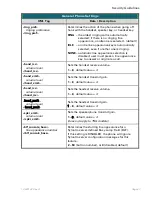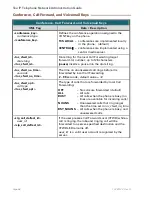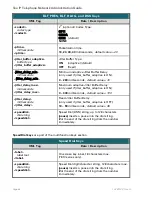
Teo IP Telephone Network Administration Guide
Page 48
13-280132 Rev. Q
D
D
i
i
a
a
l
l
P
P
l
l
a
a
n
n
S
S
e
e
t
t
t
t
i
i
n
n
g
g
s
s
A Dial Plan allows the administrator to configure the phone so that specific dial patterns
direct the phone to:
General Functionality
•
Automatically initiate a call upon recognition of a specific dial pattern
•
Add/Replace/Delete a specific prefix pattern
•
Add/Replace/Delete a specific suffix pattern
•
Generate secondary dial tone upon recognition of a specific dial pattern
•
Block access to specific dial patterns
MLPP Specific Functionality
•
Add URL parameters to the outbound INVITE
•
Add the r-priority to the called party ID display
•
Add a Resource Priority Header to the outbound INVITE
•
Add a CAL Header to the outbound INVITE
Dial Plan Settings
XML Tag
Data / Description
<
dial_plan
>
dial plan definition
</
dial_plan
>
Defines the phone’s Dial Plan.
The default dial plan is blank (no dial plan).
<
emergency_number
>
number
</
emergency_number
>
Defines the phone’s emergency number in order to
recognize when an emergency outbound call is
dialed. When this number has been dialed, the call
cannot be preempted, put on hold, conferenced or
transferred.
The default emergency number is 911.
A dial plan is stored as a text string; a null <dial_plan> does not affect user dialing in any
way. The complete BNF (Backus-Naur Form) syntax that defines the structure for the dial
plan is in Appendix B on page 75.
The dial plan is set by creating an xml entry which defines how the phone should process dialed
strings. The tag for this entry is <dial_plan>.
<dial_plan>
dial plan definition
</dial_plan>
The dial plan definition is broken down into one or more “components” which provide
specific dialing instructions. The components are separated by a “|”. (The “|” has other
uses depending on where it is used. These cases will be explained in detail later in this
section.) As each digit is dialed, it is evaluated by each component from left to right.
<dial_plan>
component1
|
component2
|
componentN
</dial_plan>
Each component can have three sections: a prefix operation, a dial pattern, and a suffix
operation. Note the placement of the brackets.
<dial_plan>{
prefix operation
}
dial string
{
suffix operation
}</dial_plan>
Summary of Contents for 4101
Page 6: ...Teo IP Telephone Network Administration Guide Page 6 13 280132 Rev Q ...
Page 16: ...Teo IP Telephone Network Administration Guide Page 16 13 280132 Rev Q ...
Page 18: ...Teo IP Telephone Network Administration Guide Page 18 13 280132 Rev Q ...
Page 23: ...XML Configuration Files 13 280132 Rev Q Page 23 ...
Page 24: ...Teo IP Telephone Network Administration Guide Page 24 13 280132 Rev Q ...
Page 70: ...Teo IP Telephone Network Administration Guide Page 70 13 280132 Rev Q ...
Page 72: ...Teo IP Telephone Network Administration Guide Page 72 13 280132 Rev Q ...
Page 86: ...Teo IP Telephone Network Administration Guide Page 86 13 280132 Rev Q ...
















































